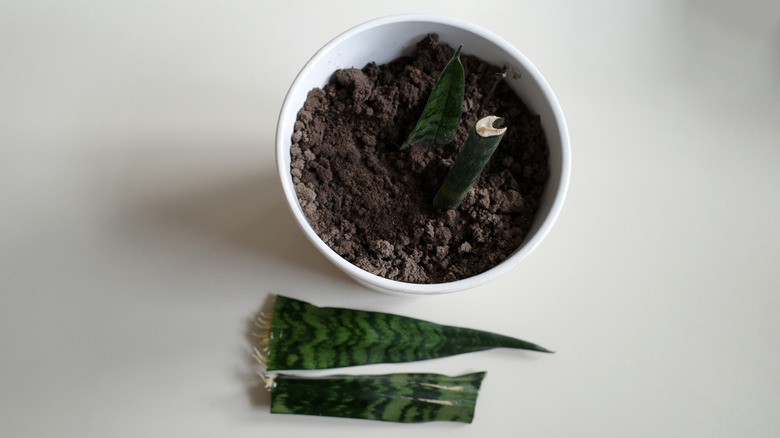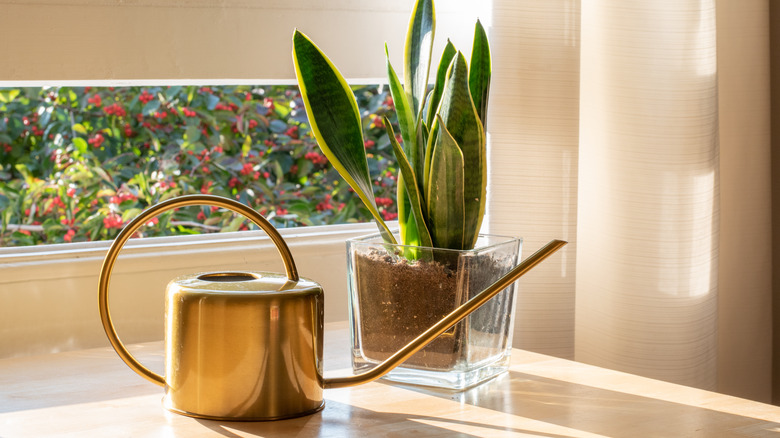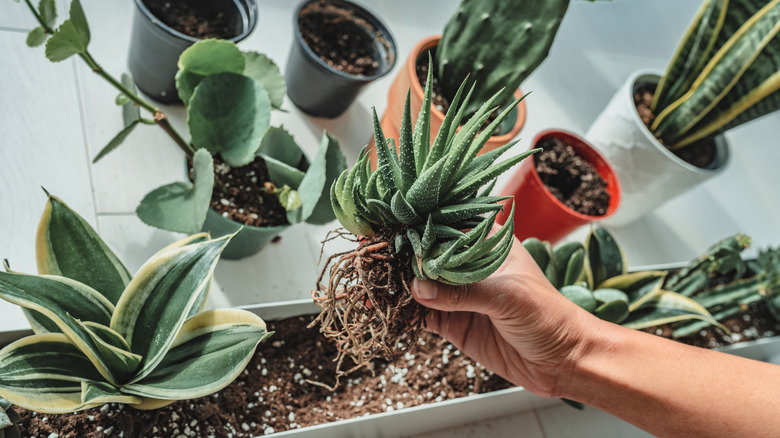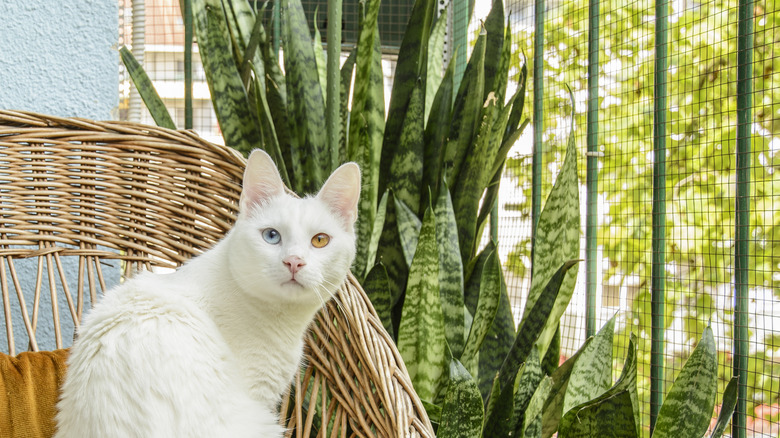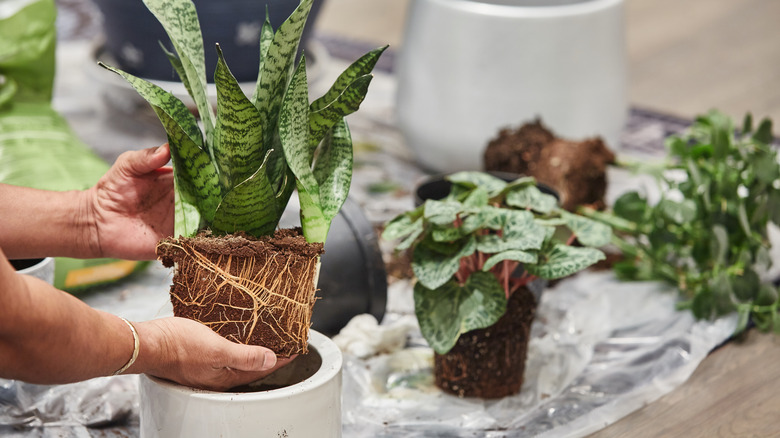Snake Plants: Everything You Should Know Before Planting
The Sansevieria trifasciata, or as houseplant owners like to call it, the snake plant or mother-in-law's tongue, is one of those no-fuss, hard-to-kill plants that are great for beginners. These are some of the easiest house plants to grow because they thrive on neglect. They aren't fussy, meaning they don't require frequent watering or humidity control, and can thrive in both dark and bright spaces.
The snake plant is native to tropical western Africa, and it prefers infrequent watering because it has adapted to rocky and dry habitats, according to Missouri Botanical Garden. As for its physical qualities, the plant is known for its vertical leaves that resemble snake tongues (hence its cheeky mother-in-law's tongue nickname), and the leaves are often dark green with light green bands. While beginners like to buy snake plants because they're hearty and are hard to kill and they're great house plants, snake plants are also beautiful garden plants that thrive in a variety of regions. Ahead is everything you should know about snake plants before planting.
How to grow snake plants
The snake plant is easy to grow in both decorative pots and soil beds, so it's a great plant to tinker with if you're a beginner gardener. When you are cultivating a young snake plant, make sure you have the proper tools to make it grow strong and healthy. Snake plants do best with a free-draining soil mix such as cactus or succulent soil mix, since they do not like to be over-watered and are prone to root rot, as noted by Plant Care Today.
Once your mix is created, plant your snake plant into a pot that has drainage holes, which allows extra water to escape into the saucer. This will ensure that the plant's roots won't sit in a puddle of water, minimizing the chance of root rot.
In order to propagate the plant from an existing snake plant, take a clean pair of sheers and cut an existing leaf from the base. You can cut the leaf into multiple pieces, and then plant those cuttings into the dirt to propagate them. Prior to planting them in the dirt, allow the cuttings to callous over for two to three days, and then plant them bottoms down into the soil. Water the cuttings a day after being planted, and watch them begin to grow.
How to care for snake plants
Snake plants are some of the easiest plants to take care of because they are unfussy by nature. They thrive in bright indirect light, but can tolerate both shade and scorching light. While snake plants do fine in dark corners, they will throw up warning signs if they're struggling and need to be moved. You will know if your snake plant needs more light if one of two things happen. First, if the plant loses its firmness and its leaves begin to flop over, that is a sign that it needs more light. Second, if the plant begins to get "leggy," which means the leaves grow thin and long, then that is another sign that it needs more light (via MindBodyGreen). While you don't want to immediately move your plant from shade to blinding light, you can slowly adapt your plant to the change by inching it closer to a window over the span of two weeks.
Snake plants are also considered low-maintenance because they thrive on being somewhat neglected. This means that they don't need to be watered often, and do much better with under-watering than over-watering. According to HGTV, you should water your plant when the soil is nearly dry. Stick your finger in the soil, and when the top two inches feel dry and crumbly, go ahead and water the plant thoroughly.
Varieties of snake plants
Not all snake plants are created equally! In fact, there are over 60 different varieties of snake plants, and they can grow anywhere from six inches to a whopping 12 feet, according to Trees.com. You can find them growing in clusters or find them sprouting individual stalks, and they can come in all sorts of color variations. As mentioned before, they are native to tropical West Africa (specifically from Nigeria to the Congo), and are often found in dry, rocky conditions. The most common species are Sansevieria trifasciata (the mother's-in-law tongue), Sansevieria cylindrica (the African spear plant), and Sansevieria masoniana (the Mason's Congo snake plant.) Other variants include:
-
Sansevieria trifasciata Futura Robusta: this variant looks just like your run-of-the-mill snake plant, but rather than having green and yellow markings, it has a blueish-green hue with black bands.
-
Sansevieria trifasciata Twisted Sister: this species also looks like a normal snake plant, save for its twisted leaves. Rather than growing straight, the leaves twist into bent curls.
-
Sansevieria ballyi Dwarf Sansevieria: this is a dwarf variety of the snake plant, and its narrow, tubular leaves only grow up to six inches tall.
-
Sansevieria trifasciata Golden Hahnii: this is another dwarf variety, and is sometimes nicknamed the "Bird's Nest" because it grows into a squat leafy bushel (per Leafy Place).
-
Sansevieria ehrenbergii Blue Sansevieria: this variant has canoe-shaped leaves that grow in a fan pattern.
Are snake plants toxic?
Pet owners need to know whether or not the house plants they're about to bring home are toxic, and sadly the snake plant can be dangerous to pets. According to the American Society for the Prevention of Cruelty to Animals (ASPCA), the snake plant has low toxicity for humans, but can harm both dogs and cats if ingested. The plant contains saponins, which is a chemical that protects the plant from insects and fungus, but it can also cause uncomfortable and potentially fatal reactions like vomiting and diarrhea if it's ingested by animals, per Plant Care Today. Additionally, the juice of the plant can also be harmful, and if it makes contact with skin it can cause skin dermatitis, which causes the skin to rash (via Snake Plant Care).
These dangers don't only apply to pets, but to humans as well. If you have toddlers or young children, it would be wise to keep these plants far from their reach.
How to repot snake plants
If snake your plant is beginning to outgrow its pot, then it might be time to repot it. This is very easy to do with a mother-in-law's tongue, and will take very little fuss. Snake plants prefer tighter pots to grow inside of, so upgrade your container by only one pot size. According to Joy Us Garden, if your snake plant is currently inside a six-inch pot, then you would need to move it into an eight-inch container.
Pour your soil mixture into the new pot, and then pop your snake plant out of its old container. Gently brush away any old dirt sticking to the root ball of the plant, and place the plant into the new pot. You want the root ball to be an inch below the top of the new planter, so fill the pot accordingly with dirt. After it's filled, pat the dirt down around the root ball, and you're ready to go!
Follow these snake plant tips and your plant will be healthy and happy for years to come.

